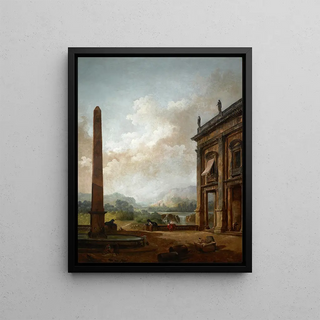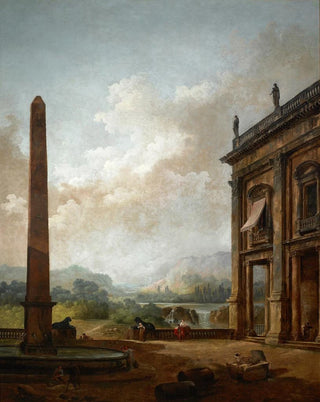Art print | L'Obélisque - Hubert Robert


View from behind

Frame (optional)
Art print L'Obélisque - Hubert Robert – Captivating Introduction
The artwork "L'Obélisque" by Hubert Robert immerses us in a universe where the past and present intertwine with rare elegance. Painted in the 18th century, this piece evokes not only the grandeur of ancient monuments but also the fascination of the era with scholarship and travel. As you contemplate this work, the viewer is immediately transported to a setting where the sublime dialogue between nature and architecture unfolds. The obelisks, symbols of the power of ancient civilizations, stand majestically, while the surrounding landscape seems to tell a timeless story. The light, subtly captured by Robert, illuminates architectural details while creating an atmosphere of serenity and contemplation.
Style and uniqueness of the work
Hubert Robert's style in "L'Obélisque" is characterized by an exceptional mastery of light and space. The artist, known for his talent in depicting ruins and landscapes, manages to create a harmonious composition where each element finds its place. The obelisks, though majestic, do not dominate the entire scene; they blend into a landscape where lush vegetation and a deep blue sky harmonize beautifully. The delicacy of brushstrokes, combined with a subtly nuanced color palette, gives the work an almost poetic quality. Shadows and lights respond to each other, creating an atmosphere that is both realistic and dreamlike, inviting the viewer to reflect on the passage of time and the ephemeral beauty of things.
The artist and his influence
Hubert Robert, often nicknamed "Robert the painter of ruins," established himself as an essential figure of the neoclassical movement. His passion for Antiquity and his interest in landscapes led him to explore themes that still resonate today. By incorporating elements of classical culture into his works, Robert paved the way for a new appreciation of the art of the past, influencing many artists of his time and future generations. His unique approach, blending realism and imagination, helped establish a dialogue between the heritage

Matte finish

View from behind

Frame (optional)
Art print L'Obélisque - Hubert Robert – Captivating Introduction
The artwork "L'Obélisque" by Hubert Robert immerses us in a universe where the past and present intertwine with rare elegance. Painted in the 18th century, this piece evokes not only the grandeur of ancient monuments but also the fascination of the era with scholarship and travel. As you contemplate this work, the viewer is immediately transported to a setting where the sublime dialogue between nature and architecture unfolds. The obelisks, symbols of the power of ancient civilizations, stand majestically, while the surrounding landscape seems to tell a timeless story. The light, subtly captured by Robert, illuminates architectural details while creating an atmosphere of serenity and contemplation.
Style and uniqueness of the work
Hubert Robert's style in "L'Obélisque" is characterized by an exceptional mastery of light and space. The artist, known for his talent in depicting ruins and landscapes, manages to create a harmonious composition where each element finds its place. The obelisks, though majestic, do not dominate the entire scene; they blend into a landscape where lush vegetation and a deep blue sky harmonize beautifully. The delicacy of brushstrokes, combined with a subtly nuanced color palette, gives the work an almost poetic quality. Shadows and lights respond to each other, creating an atmosphere that is both realistic and dreamlike, inviting the viewer to reflect on the passage of time and the ephemeral beauty of things.
The artist and his influence
Hubert Robert, often nicknamed "Robert the painter of ruins," established himself as an essential figure of the neoclassical movement. His passion for Antiquity and his interest in landscapes led him to explore themes that still resonate today. By incorporating elements of classical culture into his works, Robert paved the way for a new appreciation of the art of the past, influencing many artists of his time and future generations. His unique approach, blending realism and imagination, helped establish a dialogue between the heritage






